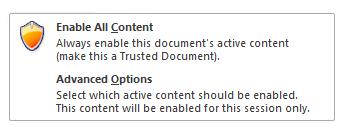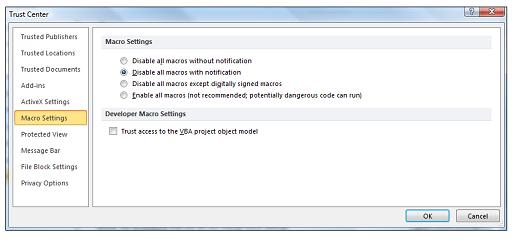Enable or disable macros in Office files
A macro is a series of commands that you can use to automate a repeated task, and can be run when you have to perform the task. This article has information about the risks involved when you work with macros, and you can learn about how to enable or disable macros in the Trust Center.
In this article
Enable macros when the Message Bar appears
When you open a file that has macros, the yellow message bar appears with a shield icon and the Enable Content button. If you know the macro, or macros, are from a reliable source, use the following instructions:
-
On the Message Bar, click Enable Content.
The file opens and is a trusted document.
The following image is an example of the Message Bar when macros are in the file.

Enable macros in the Backstage view
Another method to enable macros in a file is via the Microsoft Office Backstage view, the view that appears after you click the File tab, when the yellow Message Bar appears.
-
Click the File tab.
-
In the Security Warning area, click Enable Content.
-
Under Enable All Content, click Always enable this document's active content.
The file becomes a trusted document.
The following image is an example of the Enable Content options.

Enable macros for one time when the Security Warning appears
Use the following instructions to enable macros for the duration that the file is open. When you close the file, and then reopen it, the warning appears again.
-
Click the File tab.
-
In the Security Warning area, click Enable Content.
-
Select Advanced Options.
-
In the Microsoft Office Security Options dialog box, click Enable content for this session for each macro.
-
Click OK.
Change macro settings in the Trust Center
Macro settings are located in the Trust Center. However, if you work in an organization, the system administrator might have changed the default settings to prevent anyone from changing settings.
Important: When you change your macro settings in the Trust Center, they are changed only for the Office program that you are currently using. The macro settings are not changed for all your Office programs.
-
Click the File tab.
-
Click Options.
-
Click Trust Center, and then click Trust Center Settings.
-
In the Trust Center, click Macro Settings.
-
Make the selections that you want.
-
Click OK.
The following image is the Macro Settings area of the Trust Center.

Use the information in the following section to learn more about macro settings.
Macro settings explained
-
Disable all macros without notification Macros and security alerts about macros are disabled.
-
Disable all macros with notification Macros are disabled, but security alerts appear if there are macros present. Enable macros on a case-by-case basis.
-
Disable all macros except digitally signed macros Macros are disabled, but security alerts appear if there are macros present. However, if the macro is digitally signed by a trusted publisher, the macro runs if you have trusted the publisher. If you have not trusted the publisher, you are notified to enable the signed macro and trust the publisher.
-
Enable all macros (not recommended, potentially dangerous code can run) All macros run. This setting makes your computer vulnerable to potentially malicious code.
-
Trust access to the VBA project object model Disallow or allow programmatic access to the Visual Basic for Applications (VBA) object model from an automation client. This security option is for code written to automate an Office program and manipulate the VBA environment and object model. It is a per-user and per-application setting, and denies access by default, hindering unauthorized programs from building harmful self-replicating code. For automation clients to access the VBA object model, the user running the code must grant access. To turn on access, select the check box.
Note: Microsoft Publisher and Microsoft Access have no Trust access to the VBA project model object option.
What is a macro, who makes them, and what is the security risk?
Macros automate frequently used tasks to save time on keystrokes and mouse actions. Many were created by using Visual Basic for Applications (VBA) and are written by software developers. However, some macros can pose a potential security risk. A person with malicious intent, also known as a hacker, can introduce a destructive macro in a file that can spread a virus on your computer or into your organization's network.
No comments:
Post a Comment